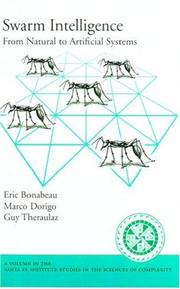| Listing 1 - 4 of 4 |
Sort by
|
Book
ISBN: 9782866014476 2866014472 Year: 1994 Publisher: Paris : Hermès,
Abstract | Keywords | Export | Availability | Bookmark
 Loading...
Loading...Choose an application
- Reference Manager
- EndNote
- RefWorks (Direct export to RefWorks)
Self-organizing systems --- Artificial intelligence --- Collective behavior --- Information technology - Social aspects --- Intelligence collective. --- Sociétés animales. --- Animaux --- Swarm intelligence. --- Animal societies. --- Animal intelligence. --- Intelligence. --- Modèles mathématiques --- Mathematical models --- Information technology --- Sociétés animales. --- Animal intelligence --- Modèles mathématiques

ISBN: 0195131584 0195131592 9786610472772 1423738802 0198030150 1280472774 1602563942 0197561489 9781423738800 9780195131581 9780195131598 9781280472770 9780198030157 9780190208196 0190208198 Year: 2020 Publisher: New York : Oxford University Press,
Abstract | Keywords | Export | Availability | Bookmark
 Loading...
Loading...Choose an application
- Reference Manager
- EndNote
- RefWorks (Direct export to RefWorks)
Social insects-ants, bees, termites, and wasps-can be viewed as powerful problem-solving systems with sophisticated collective intelligence. Composed of simple interacting agents, this intelligence lies in the networks of interactions among individuals and between individuals and the environment. This book provides a detailed look at models of social insect behaviour and how to apply these models in the design of complex systems. The book shows how these models replace an emphasis on control, preprogramming, and centralization with designs featuring autonomy, emergence, and distributed functioning. These designs are proving immensely flexible and robust, able to adapt quickly to changing environments and to continue functioning even when individual elements fail. In particular, these designs are an exciting approach to the tremendous growth of complexity in software and information.
Artificial intelligence --- Insect societies --- Insects --- Biological models --- Intelligence artificielle --- Sociétés d'insectes --- Insectes --- Modèles biologiques --- Psychology. --- Psychologie --- Swarm intelligence --- Psychology --- #TELE:SISTA --- 681.3*I21 --- 591.51 --- 591.552 --- Applications and expert systems (Artificial intelligence). Cartography. Games. Industrial automation. Law. Medicine and science. Natural language interfaces. Office automation--See also {681.3*H4}; {681.3*J} --- Psychology of animals. Animal intelligence. Instinct --- Relations between members of a species. Gregarious formations. Herds. Flocks. Colonies. Associations --- Artificial intelligence. --- Biological models. --- Insect societies. --- Insects. --- Swarm intelligence. --- Computer Science --- Engineering & Applied Sciences --- 591.552 Relations between members of a species. Gregarious formations. Herds. Flocks. Colonies. Associations --- 591.51 Psychology of animals. Animal intelligence. Instinct --- 681.3*I21 Applications and expert systems (Artificial intelligence). Cartography. Games. Industrial automation. Law. Medicine and science. Natural language interfaces. Office automation--See also {681.3*H4}; {681.3*J} --- Sociétés d'insectes --- Modèles biologiques --- Models, Biological --- Hexapoda --- Insecta --- Pterygota --- Insects, Social --- Social insects --- Collective intelligence --- AI (Artificial intelligence) --- Artificial thinking --- Electronic brains --- Intellectronics --- Intelligence, Artificial --- Intelligent machines --- Machine intelligence --- Thinking, Artificial --- Cellular automata --- Distributed artificial intelligence --- Arthropoda --- Entomology --- Animal societies --- Bionics --- Cognitive science --- Digital computer simulation --- Electronic data processing --- Logic machines --- Machine theory --- Self-organizing systems --- Simulation methods --- Fifth generation computers --- Neural computers --- Behavior --- E-books --- Insects - Psychology
Book
ISBN: 0691212929 Year: 2020 Publisher: Princeton, NJ : Princeton University Press,
Abstract | Keywords | Export | Availability | Bookmark
 Loading...
Loading...Choose an application
- Reference Manager
- EndNote
- RefWorks (Direct export to RefWorks)
The synchronized flashing of fireflies at night. The spiraling patterns of an aggregating slime mold. The anastomosing network of army-ant trails. The coordinated movements of a school of fish. Researchers are finding in such patterns--phenomena that have fascinated naturalists for centuries--a fertile new approach to understanding biological systems: the study of self-organization. This book, a primer on self-organization in biological systems for students and other enthusiasts, introduces readers to the basic concepts and tools for studying self-organization and then examines numerous examples of self-organization in the natural world. Self-organization refers to diverse pattern formation processes in the physical and biological world, from sand grains assembling into rippled dunes to cells combining to create highly structured tissues to individual insects working to create sophisticated societies. What these diverse systems hold in common is the proximate means by which they acquire order and structure. In self-organizing systems, pattern at the global level emerges solely from interactions among lower-level components. Remarkably, even very complex structures result from the iteration of surprisingly simple behaviors performed by individuals relying on only local information. This striking conclusion suggests important lines of inquiry: To what degree is environmental rather than individual complexity responsible for group complexity? To what extent have widely differing organisms adopted similar, convergent strategies of pattern formation? How, specifically, has natural selection determined the rules governing interactions within biological systems? Broad in scope, thorough yet accessible, this book is a self-contained introduction to self-organization and complexity in biology--a field of study at the forefront of life sciences research.
Biological systems. --- Self-organizing systems. --- Adamson, J. --- Attenborough, David. --- Bagnoli, P. --- Buck, E. --- Bénard convection. --- Craig, W. --- Downing, H. A. --- Fick's Law. --- Franks, N. R. --- Grassé, P. P. --- Hanson, F. E. --- Heinrich, B. --- Jeanne, R. L. --- Kauffman, S. A. --- Luciola pupilla (firefly). --- Maruyama, M. --- Myerscough, M. R. --- Oecophylla sp. --- Pardi, L. --- Partridge, B. L. --- Schneirla, T. C., Turillazzi, S. --- decentralized control. --- electric fish electrolocation. --- evolutionary theories. --- inclusive fitness theory.
Book
ISBN: 9780691212920 Year: 2020 Publisher: Princeton, NJ
Abstract | Keywords | Export | Availability | Bookmark
 Loading...
Loading...Choose an application
- Reference Manager
- EndNote
- RefWorks (Direct export to RefWorks)
| Listing 1 - 4 of 4 |
Sort by
|

 Search
Search Feedback
Feedback About UniCat
About UniCat  Help
Help News
News